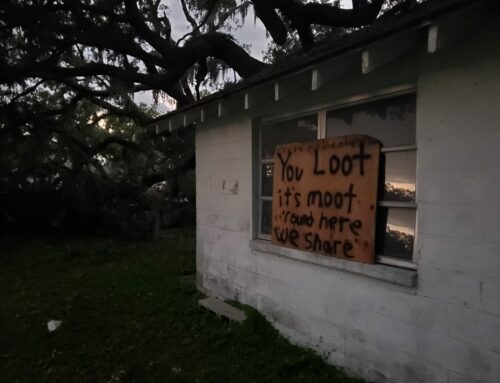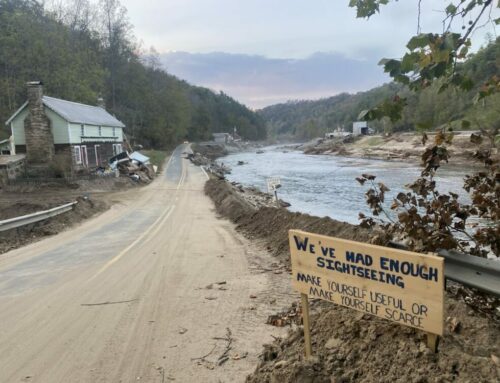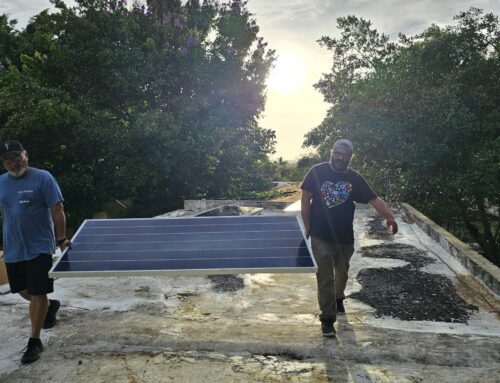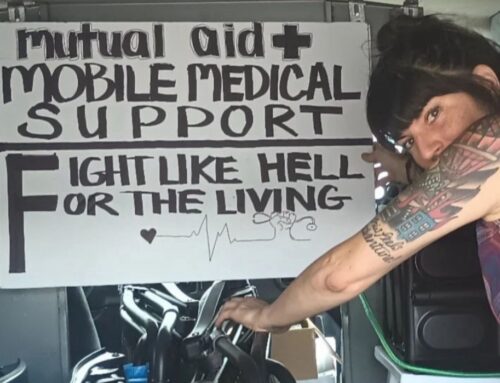The following is a report back for a relief trip to the Florida Keys made possible by the work of numerous folks involved with Mutual Aid Disaster Relief (MADR). The immense amount of support and solidarity provided for those in need exists through the collaboration of various communities that came together in times of crisis. This represents the perspective and response of anarchist comrades, yet there are a number of different political orientations for those involved with MADR. As the predatory nature of the State continues to benefit from disasters such as these, we feel it is crucial to give space to anti-state and anti-authoritarian voices in order to continue to remind us in the storm after the storm, who the true enemy is.
“Yet, before we even entered, there were a number of other obstacles in our way constructed by the State and the non-profit industrial complex looking to take advantage of successes in autonomous organizing and the opportunities that disaster provides.”
On 9/18 Monday morning at 3 AM a group of 9 folks left “The Hub” (5107 N. Central Ave.) in Tampa to drive to the Florida Keys with a 12 ft truck loaded with food, water, and other necessities, as the U.S. Highway 1 checkpoint established in Florida City after Hurricane Irma, was to be terminated Tuesday at 7:30 AM. Although police stated that only residents, business owners, disaster workers and supply vehicles with proper identification would be allowed to enter until further notice.
It had been a week since residents who were able to leave had evacuated and they were just now returning to their homes, or what was left of them. The hurricane’s last minute shift to the western coast of Florida put the Florida Keys (especially the Middle Keys such as Marathon, and Lower Keys; Big Key Pine, Little Torch Key, and Key West) directly in the storm’s path, as it made landfall on Sunday, September 10th.
In order to provide much needed aid to those neglected by the Red Cross and FEMA, we drove with a van full of medical supplies and a 12 ft moving truck filled with food, water, and other necessities to the poorest areas. Yet, before we even entered, there were a number of other obstacles in our way constructed by the State and the non-profit industrial complex looking to take advantage of successes in autonomous organizing and the opportunities that disasters provide. The immense amount of supplies that have been collected at “The Hub” in the past couple weeks was made possible through the long-standing connections between various radical communities and the donation of the space from the St. Paul Lutheran Church.
A non-profit organization called “Coalition of Hope” told us there were still many checkpoints throughout the keys and we would need an official invitation to do relief work in order to be allowed in. After promising us the necessary clearance, they also slowly revealed their other intentions, which was for us to come to their station in Key West and drop off our supplies at their distribution center where they could be sorted and organized. They also stated that they were feeding the police, relief workers, National Guard troops, and FEMA, along with protecting property there from looters, although they made little to no mention of the actual neighborhoods or people they were serving.
“They also stated that they were feeding the police, relief workers, National Guard troops, and FEMA, along with protecting property there from looters, although they made little to no mention of the actual neighborhoods or people they were serving.”
When we asked about where the poorest or hardest hit areas were they strongly said we should not go to those areas on our own, but should instead rely on them to distribute the goods as needed. By the State’s insistence on protecting property rather than responding to the urgency of feeding poor, hungry, and desperate people without food, water, or power, the necessity of our actions became all the more clear. It is what we saw during Hurricane Katrina, Sandy, and Harvey yet it exists on a much larger scale, as the continued neglect and impoverishment of black and brown communities who suffer the most during environmental disasters, are also those who endure the most state violence on a day-to-day basis.
After re-affirming with our group that we would absolutely not cooperate with the police or military, we decided to use the credentials to get us through but then to cease any communication with that organization once in the keys. Once we easily made our way through the first and only checkpoint, this narrative of limited access seemed to be less about safety and more about controlling who provides aid to whom in order to deter mutual aid relief efforts from autonomous workers. As seen during Hurricane Katrina, organizers with the Common Ground Collective were treated as criminals or “insurgents,” and a threat to the control of militarized terror that paramilitary groups extended throughout New Orleans.
Without any designated drop-points or sites to go to, we searched for affordable and section 8 housing to try to find neglected neighborhoods in need. Upon entering Key Largo, the first island in the Florida Keys, we were immediately greeted with large construction signs warning residents to boil their water in Monroe County and the curfew in place from 10 PM – 6 AM. Trees and debris were scattered everywhere, power lines were still down and much of the area seemed to be still evacuated, except for the very vocal signage warning potential trespassers of the now common, “You Loot, We Shoot” slogan.
This was not the first time we would see this phrase used to support white supremacist fantasies of black greed and criminality, as its repetition re-affirmed the desire to protect property over human life, or to reassert that property is more valuable than the lives of those suffering. Since Katrina, this narrative has solidified into a matter of fact coupled with the fear of black desperation, treating those in need as if they are animals to be controlled and approached with great caution. For racist NGOs such as the Red Cross, poor black and brown neighborhoods are regarded as war-zones, while folks in these communities often remain trapped with limited resources or remain at the whim of vigilante justice from anyone who accuses them of committing crimes.
“At the first housing project we went to in Key Largo, we were met with an overwhelming sense of desperation from those living there. Many were still without power and they said that no one had come through to see if they needed anything.”
At the first housing project we went to in Key Largo, we were met with an overwhelming sense of desperation from those living there. Many were still without power and they said that no one had come through to see if they needed anything. Rather than rationing out any items, we would climb into the truck and start passing out cases of bottled water and asking people what they wanted. Canned soup, diapers, baby wipes, paper towels, MREs, fruit snacks, bread and anything else we could dig to find in the packed truck. There was never a moment of the supposed “chaos” we were warned against, as we let people take whatever they needed and they were always the first to insist on leaving more for others.
Later in the afternoon as we drove further down to Marathon Key, signs of brutal devastation were everywhere. The sheer force of the hurricane had uprooted enormous trees, toppled signs, tore roofs and metal siding off of buildings, and knocked over gas station awnings. Massive storm surges left small trailers, boats, and jet skis on the side of the road as if they were driftwood. Appliances were shredded to pieces after being ripped from houses by the powerful waves. An initial estimate by FEMA reported over 90% of homes were damaged in the Florida Keys and 25% were completely destroyed, although as residents begin to go back those numbers will likely increase.
In the wake of this destruction the State and Monroe County officials have done little to provide for those returning, suggesting instead they apply for emergency funds and be prepared to bring all the necessary supplies they might need to survive. Yet this supposed lack of available resources is countered by claims of Monroe County officials, who have ensured a “saturated” law enforcement presence in the hardest hit region between the Seven Mile Bridge and Key West. It is not surprising that while police respond to this disaster with strict policing and force, those who are victims of the catastrophe are left to fend for themselves. Thus the need for aid and support was felt everywhere we went, as our actions were met with immense gratitude. People saying we were a godsend and an answer to their prayers. In contradiction to the idea of lawless peril, many people who had just lost everything were always thinking about how they could help others in their community.
“It is not surprising that while police respond to this disaster with strict policing and force, those who are victims of the catastrophe are left to fend for themselves.”
Nearing the end of our trip when we had almost dispersed all the goods, we continued on to another housing project to see if folks needed water, cleaning supplies, medical attention, and to find someone who could put a brand new generator to use. We made a wrong turn in the truck and drove down a street lined by abandoned cars and decimated houses overflowing with trash. We drove by one couple living in their car, so we stopped to give them water. The man said that he only wanted water and he wanted to show me why. He brought me around to the backseat of his car to reveal a large plastic bin in the backseat filled with bubbling water. He reached in and pulled out a catfish, which he said was one of his best friends and all they really had left. They took a few cleaning supplies to try to salvage what they could from their home, but mostly they urged us to go where other folks need even more help. We went up the road to a trailer park community called Galway Bay, which was completely destroyed. We talked to a woman who had recently come back and pointed to the trailers of where all of her best friends live. She was finally in remission from breast cancer and talked about resilience and the strength she knew they all had in order to build again. After walking around the complex we finally found someone to take the generator, a group of 4 neighbors living in their partially demolished trailers, who agreed to share it with each other.
A summation of the situation and reality on the ground in the Keys would be a noted lamentation that the State and the non-profit industrial complex in their post-disaster vulturism—predicated on the traumas of collective shock and awe of the citizenry—continue to position themselves as a wholly unnecessary wedge between the resources available (people power, supplies, solidarity) and the disaster affected communities. The legitimacy of this wedge is asserted through the false narrative of frenzied looters hellbent on pillage at any cost. We can write the epilogue for this story before it even ends, as “American” history has been nothing if not predictable. The storm after the storm will be one of gentrification, abandonment of the poor, and the further entrenchment of State power through disaster capitalism.
In Solidarity,
Anarchist Comrades of Mutual Aid Disaster Relief (MADR)
